Assignment on Immune System - Definition
VerifiedAdded on 2022/08/29
|14
|3969
|24
AI Summary
Contribute Materials
Your contribution can guide someone’s learning journey. Share your
documents today.
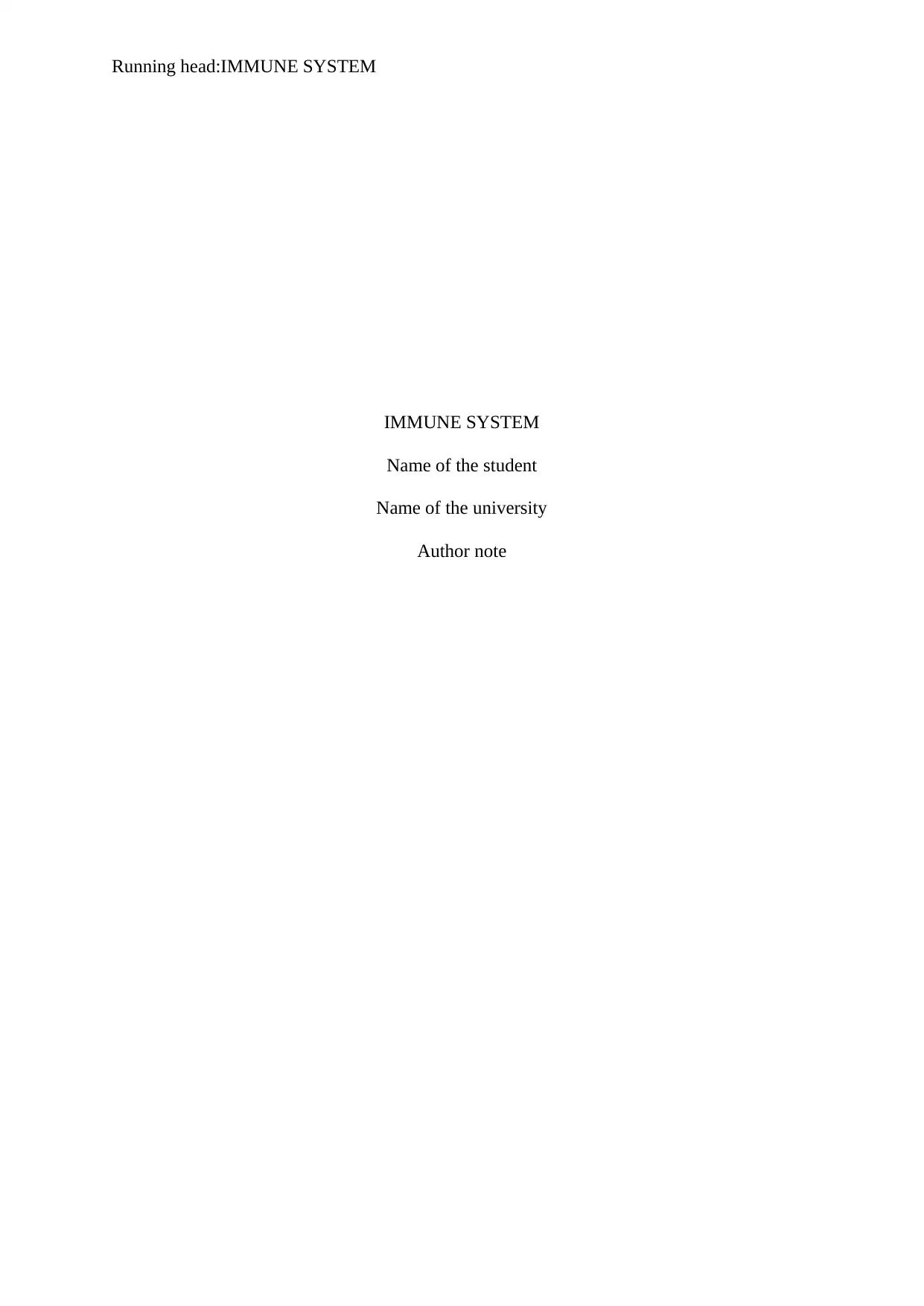
Running head:IMMUNE SYSTEM
IMMUNE SYSTEM
Name of the student
Name of the university
Author note
IMMUNE SYSTEM
Name of the student
Name of the university
Author note
Secure Best Marks with AI Grader
Need help grading? Try our AI Grader for instant feedback on your assignments.
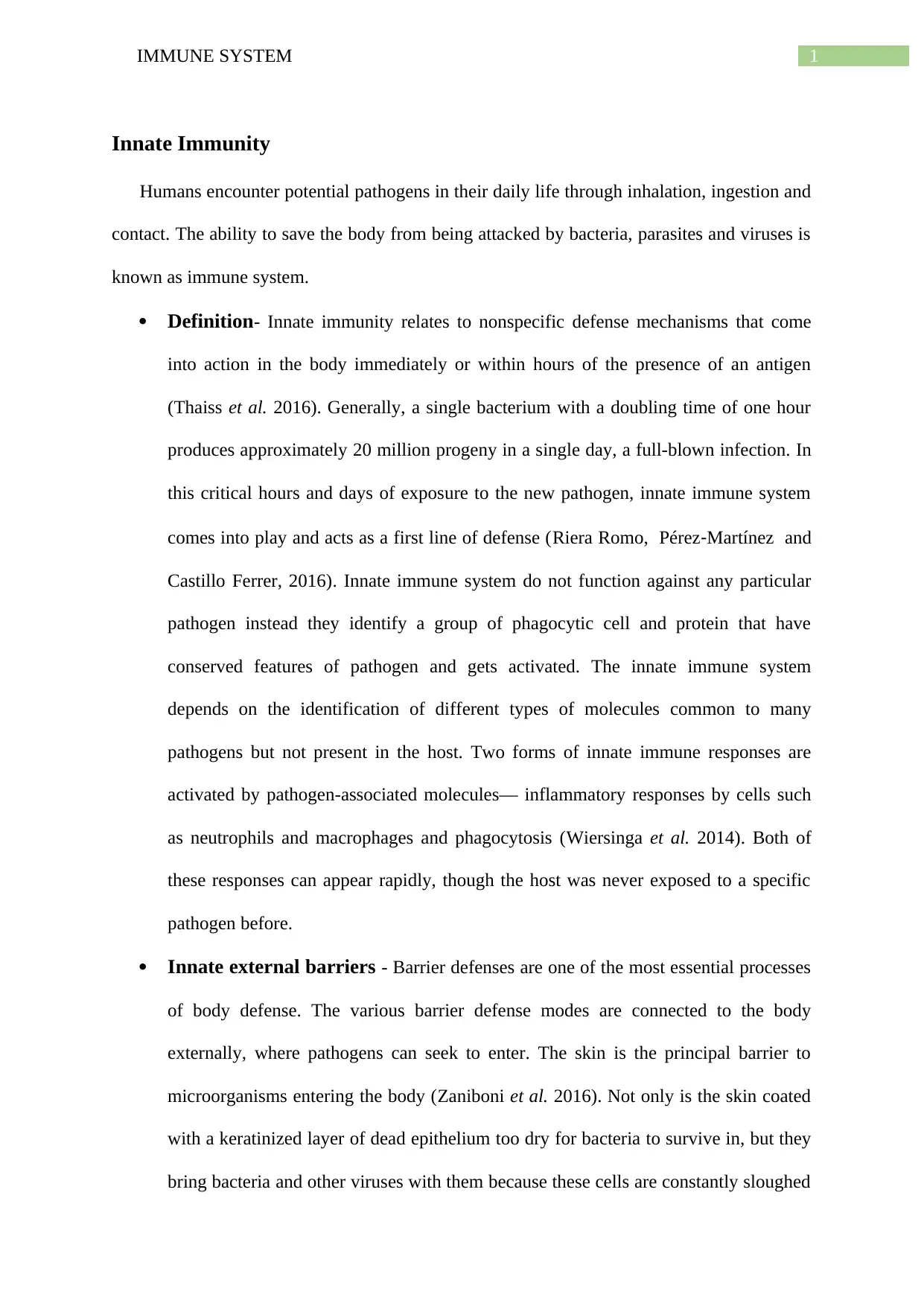
1IMMUNE SYSTEM
Innate Immunity
Humans encounter potential pathogens in their daily life through inhalation, ingestion and
contact. The ability to save the body from being attacked by bacteria, parasites and viruses is
known as immune system.
Definition- Innate immunity relates to nonspecific defense mechanisms that come
into action in the body immediately or within hours of the presence of an antigen
(Thaiss et al. 2016). Generally, a single bacterium with a doubling time of one hour
produces approximately 20 million progeny in a single day, a full-blown infection. In
this critical hours and days of exposure to the new pathogen, innate immune system
comes into play and acts as a first line of defense (Riera Romo, Pérez‐Martínez and
Castillo Ferrer, 2016). Innate immune system do not function against any particular
pathogen instead they identify a group of phagocytic cell and protein that have
conserved features of pathogen and gets activated. The innate immune system
depends on the identification of different types of molecules common to many
pathogens but not present in the host. Two forms of innate immune responses are
activated by pathogen-associated molecules— inflammatory responses by cells such
as neutrophils and macrophages and phagocytosis (Wiersinga et al. 2014). Both of
these responses can appear rapidly, though the host was never exposed to a specific
pathogen before.
Innate external barriers - Barrier defenses are one of the most essential processes
of body defense. The various barrier defense modes are connected to the body
externally, where pathogens can seek to enter. The skin is the principal barrier to
microorganisms entering the body (Zaniboni et al. 2016). Not only is the skin coated
with a keratinized layer of dead epithelium too dry for bacteria to survive in, but they
bring bacteria and other viruses with them because these cells are constantly sloughed
Innate Immunity
Humans encounter potential pathogens in their daily life through inhalation, ingestion and
contact. The ability to save the body from being attacked by bacteria, parasites and viruses is
known as immune system.
Definition- Innate immunity relates to nonspecific defense mechanisms that come
into action in the body immediately or within hours of the presence of an antigen
(Thaiss et al. 2016). Generally, a single bacterium with a doubling time of one hour
produces approximately 20 million progeny in a single day, a full-blown infection. In
this critical hours and days of exposure to the new pathogen, innate immune system
comes into play and acts as a first line of defense (Riera Romo, Pérez‐Martínez and
Castillo Ferrer, 2016). Innate immune system do not function against any particular
pathogen instead they identify a group of phagocytic cell and protein that have
conserved features of pathogen and gets activated. The innate immune system
depends on the identification of different types of molecules common to many
pathogens but not present in the host. Two forms of innate immune responses are
activated by pathogen-associated molecules— inflammatory responses by cells such
as neutrophils and macrophages and phagocytosis (Wiersinga et al. 2014). Both of
these responses can appear rapidly, though the host was never exposed to a specific
pathogen before.
Innate external barriers - Barrier defenses are one of the most essential processes
of body defense. The various barrier defense modes are connected to the body
externally, where pathogens can seek to enter. The skin is the principal barrier to
microorganisms entering the body (Zaniboni et al. 2016). Not only is the skin coated
with a keratinized layer of dead epithelium too dry for bacteria to survive in, but they
bring bacteria and other viruses with them because these cells are constantly sloughed
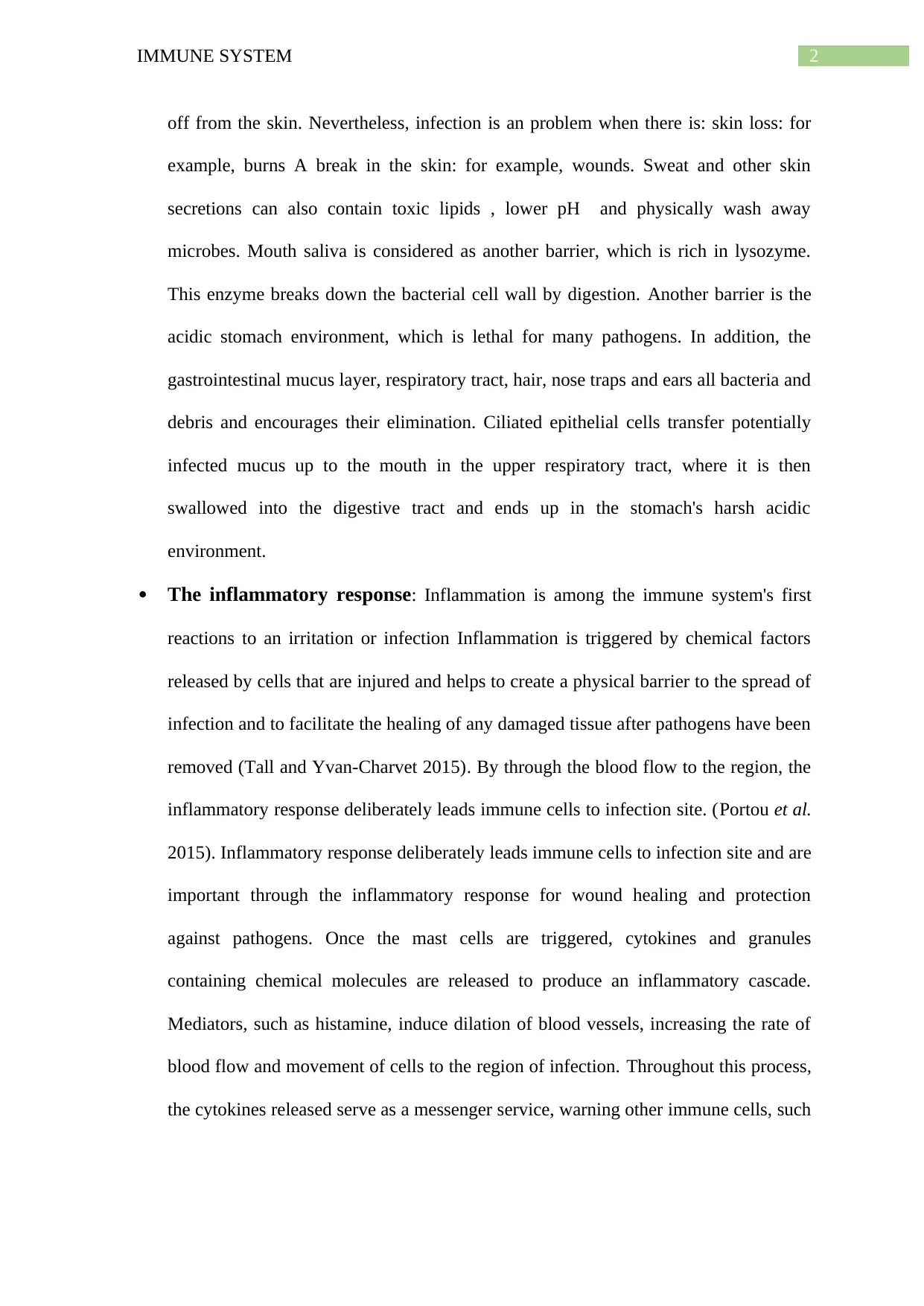
2IMMUNE SYSTEM
off from the skin. Nevertheless, infection is an problem when there is: skin loss: for
example, burns A break in the skin: for example, wounds. Sweat and other skin
secretions can also contain toxic lipids , lower pH and physically wash away
microbes. Mouth saliva is considered as another barrier, which is rich in lysozyme.
This enzyme breaks down the bacterial cell wall by digestion. Another barrier is the
acidic stomach environment, which is lethal for many pathogens. In addition, the
gastrointestinal mucus layer, respiratory tract, hair, nose traps and ears all bacteria and
debris and encourages their elimination. Ciliated epithelial cells transfer potentially
infected mucus up to the mouth in the upper respiratory tract, where it is then
swallowed into the digestive tract and ends up in the stomach's harsh acidic
environment.
The inflammatory response: Inflammation is among the immune system's first
reactions to an irritation or infection Inflammation is triggered by chemical factors
released by cells that are injured and helps to create a physical barrier to the spread of
infection and to facilitate the healing of any damaged tissue after pathogens have been
removed (Tall and Yvan-Charvet 2015). By through the blood flow to the region, the
inflammatory response deliberately leads immune cells to infection site. (Portou et al.
2015). Inflammatory response deliberately leads immune cells to infection site and are
important through the inflammatory response for wound healing and protection
against pathogens. Once the mast cells are triggered, cytokines and granules
containing chemical molecules are released to produce an inflammatory cascade.
Mediators, such as histamine, induce dilation of blood vessels, increasing the rate of
blood flow and movement of cells to the region of infection. Throughout this process,
the cytokines released serve as a messenger service, warning other immune cells, such
off from the skin. Nevertheless, infection is an problem when there is: skin loss: for
example, burns A break in the skin: for example, wounds. Sweat and other skin
secretions can also contain toxic lipids , lower pH and physically wash away
microbes. Mouth saliva is considered as another barrier, which is rich in lysozyme.
This enzyme breaks down the bacterial cell wall by digestion. Another barrier is the
acidic stomach environment, which is lethal for many pathogens. In addition, the
gastrointestinal mucus layer, respiratory tract, hair, nose traps and ears all bacteria and
debris and encourages their elimination. Ciliated epithelial cells transfer potentially
infected mucus up to the mouth in the upper respiratory tract, where it is then
swallowed into the digestive tract and ends up in the stomach's harsh acidic
environment.
The inflammatory response: Inflammation is among the immune system's first
reactions to an irritation or infection Inflammation is triggered by chemical factors
released by cells that are injured and helps to create a physical barrier to the spread of
infection and to facilitate the healing of any damaged tissue after pathogens have been
removed (Tall and Yvan-Charvet 2015). By through the blood flow to the region, the
inflammatory response deliberately leads immune cells to infection site. (Portou et al.
2015). Inflammatory response deliberately leads immune cells to infection site and are
important through the inflammatory response for wound healing and protection
against pathogens. Once the mast cells are triggered, cytokines and granules
containing chemical molecules are released to produce an inflammatory cascade.
Mediators, such as histamine, induce dilation of blood vessels, increasing the rate of
blood flow and movement of cells to the region of infection. Throughout this process,
the cytokines released serve as a messenger service, warning other immune cells, such
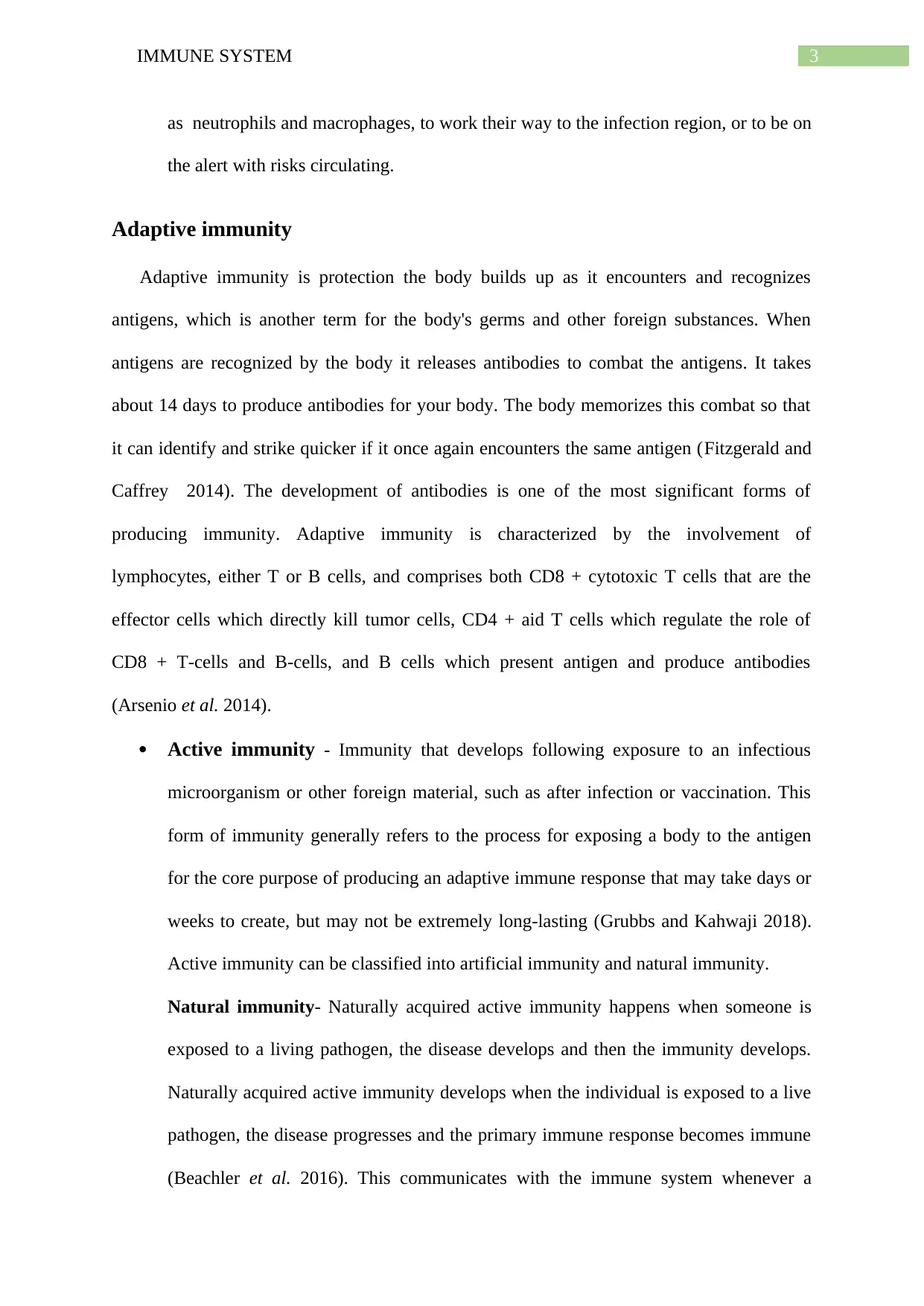
3IMMUNE SYSTEM
as neutrophils and macrophages, to work their way to the infection region, or to be on
the alert with risks circulating.
Adaptive immunity
Adaptive immunity is protection the body builds up as it encounters and recognizes
antigens, which is another term for the body's germs and other foreign substances. When
antigens are recognized by the body it releases antibodies to combat the antigens. It takes
about 14 days to produce antibodies for your body. The body memorizes this combat so that
it can identify and strike quicker if it once again encounters the same antigen (Fitzgerald and
Caffrey 2014). The development of antibodies is one of the most significant forms of
producing immunity. Adaptive immunity is characterized by the involvement of
lymphocytes, either T or B cells, and comprises both CD8 + cytotoxic T cells that are the
effector cells which directly kill tumor cells, CD4 + aid T cells which regulate the role of
CD8 + T-cells and B-cells, and B cells which present antigen and produce antibodies
(Arsenio et al. 2014).
Active immunity - Immunity that develops following exposure to an infectious
microorganism or other foreign material, such as after infection or vaccination. This
form of immunity generally refers to the process for exposing a body to the antigen
for the core purpose of producing an adaptive immune response that may take days or
weeks to create, but may not be extremely long-lasting (Grubbs and Kahwaji 2018).
Active immunity can be classified into artificial immunity and natural immunity.
Natural immunity- Naturally acquired active immunity happens when someone is
exposed to a living pathogen, the disease develops and then the immunity develops.
Naturally acquired active immunity develops when the individual is exposed to a live
pathogen, the disease progresses and the primary immune response becomes immune
(Beachler et al. 2016). This communicates with the immune system whenever a
as neutrophils and macrophages, to work their way to the infection region, or to be on
the alert with risks circulating.
Adaptive immunity
Adaptive immunity is protection the body builds up as it encounters and recognizes
antigens, which is another term for the body's germs and other foreign substances. When
antigens are recognized by the body it releases antibodies to combat the antigens. It takes
about 14 days to produce antibodies for your body. The body memorizes this combat so that
it can identify and strike quicker if it once again encounters the same antigen (Fitzgerald and
Caffrey 2014). The development of antibodies is one of the most significant forms of
producing immunity. Adaptive immunity is characterized by the involvement of
lymphocytes, either T or B cells, and comprises both CD8 + cytotoxic T cells that are the
effector cells which directly kill tumor cells, CD4 + aid T cells which regulate the role of
CD8 + T-cells and B-cells, and B cells which present antigen and produce antibodies
(Arsenio et al. 2014).
Active immunity - Immunity that develops following exposure to an infectious
microorganism or other foreign material, such as after infection or vaccination. This
form of immunity generally refers to the process for exposing a body to the antigen
for the core purpose of producing an adaptive immune response that may take days or
weeks to create, but may not be extremely long-lasting (Grubbs and Kahwaji 2018).
Active immunity can be classified into artificial immunity and natural immunity.
Natural immunity- Naturally acquired active immunity happens when someone is
exposed to a living pathogen, the disease develops and then the immunity develops.
Naturally acquired active immunity develops when the individual is exposed to a live
pathogen, the disease progresses and the primary immune response becomes immune
(Beachler et al. 2016). This communicates with the immune system whenever a
Secure Best Marks with AI Grader
Need help grading? Try our AI Grader for instant feedback on your assignments.
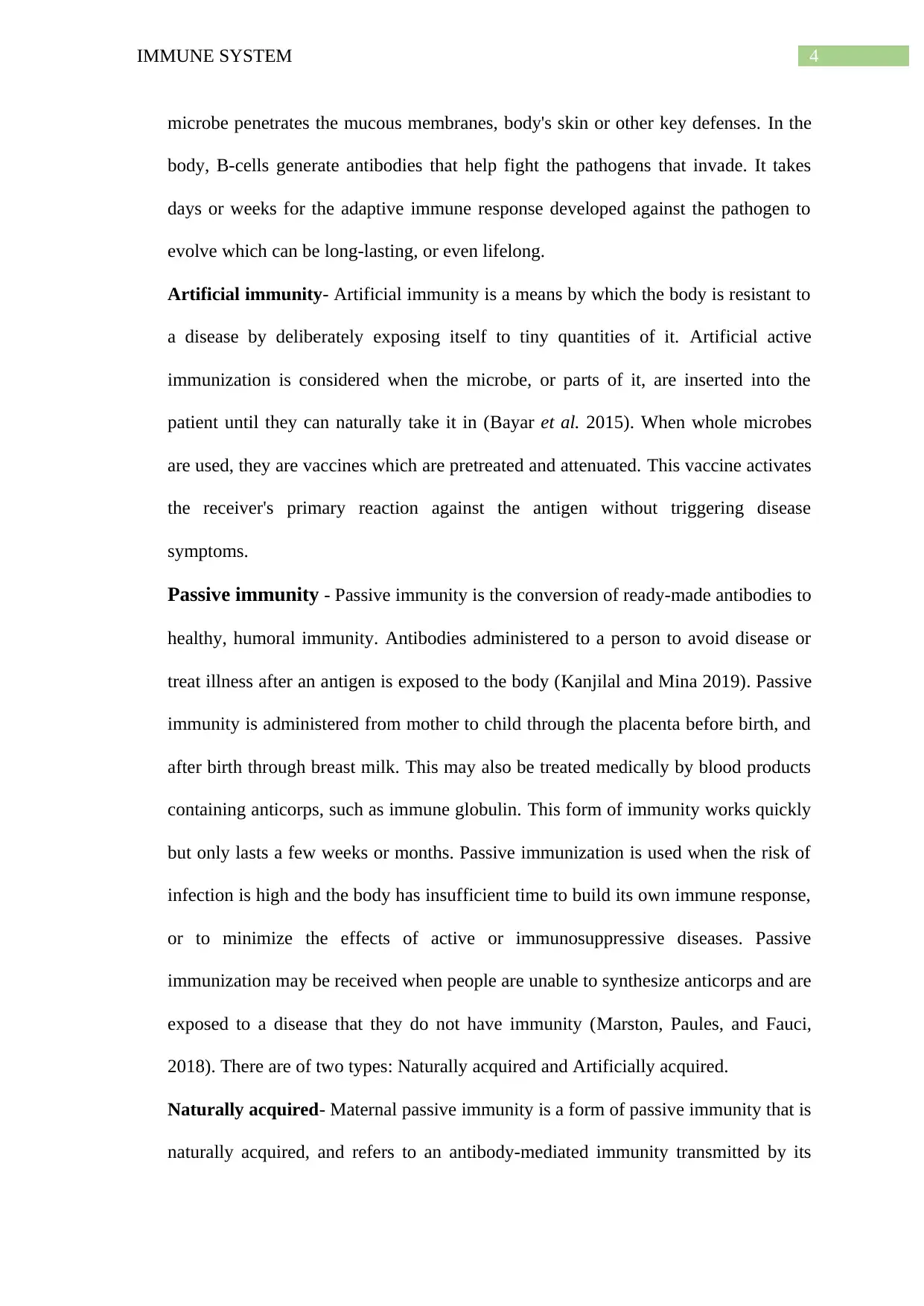
4IMMUNE SYSTEM
microbe penetrates the mucous membranes, body's skin or other key defenses. In the
body, B-cells generate antibodies that help fight the pathogens that invade. It takes
days or weeks for the adaptive immune response developed against the pathogen to
evolve which can be long-lasting, or even lifelong.
Artificial immunity- Artificial immunity is a means by which the body is resistant to
a disease by deliberately exposing itself to tiny quantities of it. Artificial active
immunization is considered when the microbe, or parts of it, are inserted into the
patient until they can naturally take it in (Bayar et al. 2015). When whole microbes
are used, they are vaccines which are pretreated and attenuated. This vaccine activates
the receiver's primary reaction against the antigen without triggering disease
symptoms.
Passive immunity - Passive immunity is the conversion of ready-made antibodies to
healthy, humoral immunity. Antibodies administered to a person to avoid disease or
treat illness after an antigen is exposed to the body (Kanjilal and Mina 2019). Passive
immunity is administered from mother to child through the placenta before birth, and
after birth through breast milk. This may also be treated medically by blood products
containing anticorps, such as immune globulin. This form of immunity works quickly
but only lasts a few weeks or months. Passive immunization is used when the risk of
infection is high and the body has insufficient time to build its own immune response,
or to minimize the effects of active or immunosuppressive diseases. Passive
immunization may be received when people are unable to synthesize anticorps and are
exposed to a disease that they do not have immunity (Marston, Paules, and Fauci,
2018). There are of two types: Naturally acquired and Artificially acquired.
Naturally acquired- Maternal passive immunity is a form of passive immunity that is
naturally acquired, and refers to an antibody-mediated immunity transmitted by its
microbe penetrates the mucous membranes, body's skin or other key defenses. In the
body, B-cells generate antibodies that help fight the pathogens that invade. It takes
days or weeks for the adaptive immune response developed against the pathogen to
evolve which can be long-lasting, or even lifelong.
Artificial immunity- Artificial immunity is a means by which the body is resistant to
a disease by deliberately exposing itself to tiny quantities of it. Artificial active
immunization is considered when the microbe, or parts of it, are inserted into the
patient until they can naturally take it in (Bayar et al. 2015). When whole microbes
are used, they are vaccines which are pretreated and attenuated. This vaccine activates
the receiver's primary reaction against the antigen without triggering disease
symptoms.
Passive immunity - Passive immunity is the conversion of ready-made antibodies to
healthy, humoral immunity. Antibodies administered to a person to avoid disease or
treat illness after an antigen is exposed to the body (Kanjilal and Mina 2019). Passive
immunity is administered from mother to child through the placenta before birth, and
after birth through breast milk. This may also be treated medically by blood products
containing anticorps, such as immune globulin. This form of immunity works quickly
but only lasts a few weeks or months. Passive immunization is used when the risk of
infection is high and the body has insufficient time to build its own immune response,
or to minimize the effects of active or immunosuppressive diseases. Passive
immunization may be received when people are unable to synthesize anticorps and are
exposed to a disease that they do not have immunity (Marston, Paules, and Fauci,
2018). There are of two types: Naturally acquired and Artificially acquired.
Naturally acquired- Maternal passive immunity is a form of passive immunity that is
naturally acquired, and refers to an antibody-mediated immunity transmitted by its
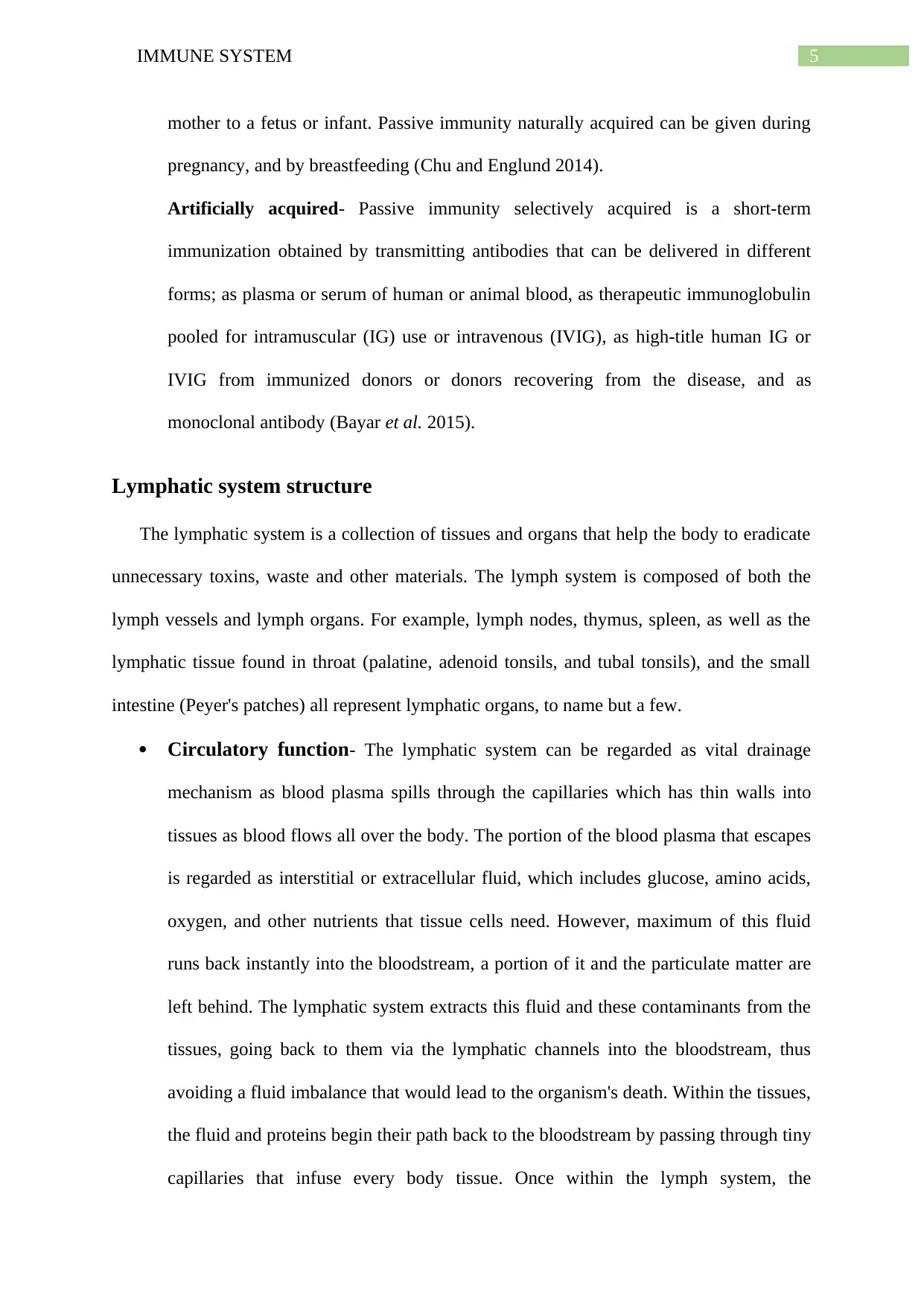
5IMMUNE SYSTEM
mother to a fetus or infant. Passive immunity naturally acquired can be given during
pregnancy, and by breastfeeding (Chu and Englund 2014).
Artificially acquired- Passive immunity selectively acquired is a short-term
immunization obtained by transmitting antibodies that can be delivered in different
forms; as plasma or serum of human or animal blood, as therapeutic immunoglobulin
pooled for intramuscular (IG) use or intravenous (IVIG), as high-title human IG or
IVIG from immunized donors or donors recovering from the disease, and as
monoclonal antibody (Bayar et al. 2015).
Lymphatic system structure
The lymphatic system is a collection of tissues and organs that help the body to eradicate
unnecessary toxins, waste and other materials. The lymph system is composed of both the
lymph vessels and lymph organs. For example, lymph nodes, thymus, spleen, as well as the
lymphatic tissue found in throat (palatine, adenoid tonsils, and tubal tonsils), and the small
intestine (Peyer's patches) all represent lymphatic organs, to name but a few.
Circulatory function- The lymphatic system can be regarded as vital drainage
mechanism as blood plasma spills through the capillaries which has thin walls into
tissues as blood flows all over the body. The portion of the blood plasma that escapes
is regarded as interstitial or extracellular fluid, which includes glucose, amino acids,
oxygen, and other nutrients that tissue cells need. However, maximum of this fluid
runs back instantly into the bloodstream, a portion of it and the particulate matter are
left behind. The lymphatic system extracts this fluid and these contaminants from the
tissues, going back to them via the lymphatic channels into the bloodstream, thus
avoiding a fluid imbalance that would lead to the organism's death. Within the tissues,
the fluid and proteins begin their path back to the bloodstream by passing through tiny
capillaries that infuse every body tissue. Once within the lymph system, the
mother to a fetus or infant. Passive immunity naturally acquired can be given during
pregnancy, and by breastfeeding (Chu and Englund 2014).
Artificially acquired- Passive immunity selectively acquired is a short-term
immunization obtained by transmitting antibodies that can be delivered in different
forms; as plasma or serum of human or animal blood, as therapeutic immunoglobulin
pooled for intramuscular (IG) use or intravenous (IVIG), as high-title human IG or
IVIG from immunized donors or donors recovering from the disease, and as
monoclonal antibody (Bayar et al. 2015).
Lymphatic system structure
The lymphatic system is a collection of tissues and organs that help the body to eradicate
unnecessary toxins, waste and other materials. The lymph system is composed of both the
lymph vessels and lymph organs. For example, lymph nodes, thymus, spleen, as well as the
lymphatic tissue found in throat (palatine, adenoid tonsils, and tubal tonsils), and the small
intestine (Peyer's patches) all represent lymphatic organs, to name but a few.
Circulatory function- The lymphatic system can be regarded as vital drainage
mechanism as blood plasma spills through the capillaries which has thin walls into
tissues as blood flows all over the body. The portion of the blood plasma that escapes
is regarded as interstitial or extracellular fluid, which includes glucose, amino acids,
oxygen, and other nutrients that tissue cells need. However, maximum of this fluid
runs back instantly into the bloodstream, a portion of it and the particulate matter are
left behind. The lymphatic system extracts this fluid and these contaminants from the
tissues, going back to them via the lymphatic channels into the bloodstream, thus
avoiding a fluid imbalance that would lead to the organism's death. Within the tissues,
the fluid and proteins begin their path back to the bloodstream by passing through tiny
capillaries that infuse every body tissue. Once within the lymph system, the
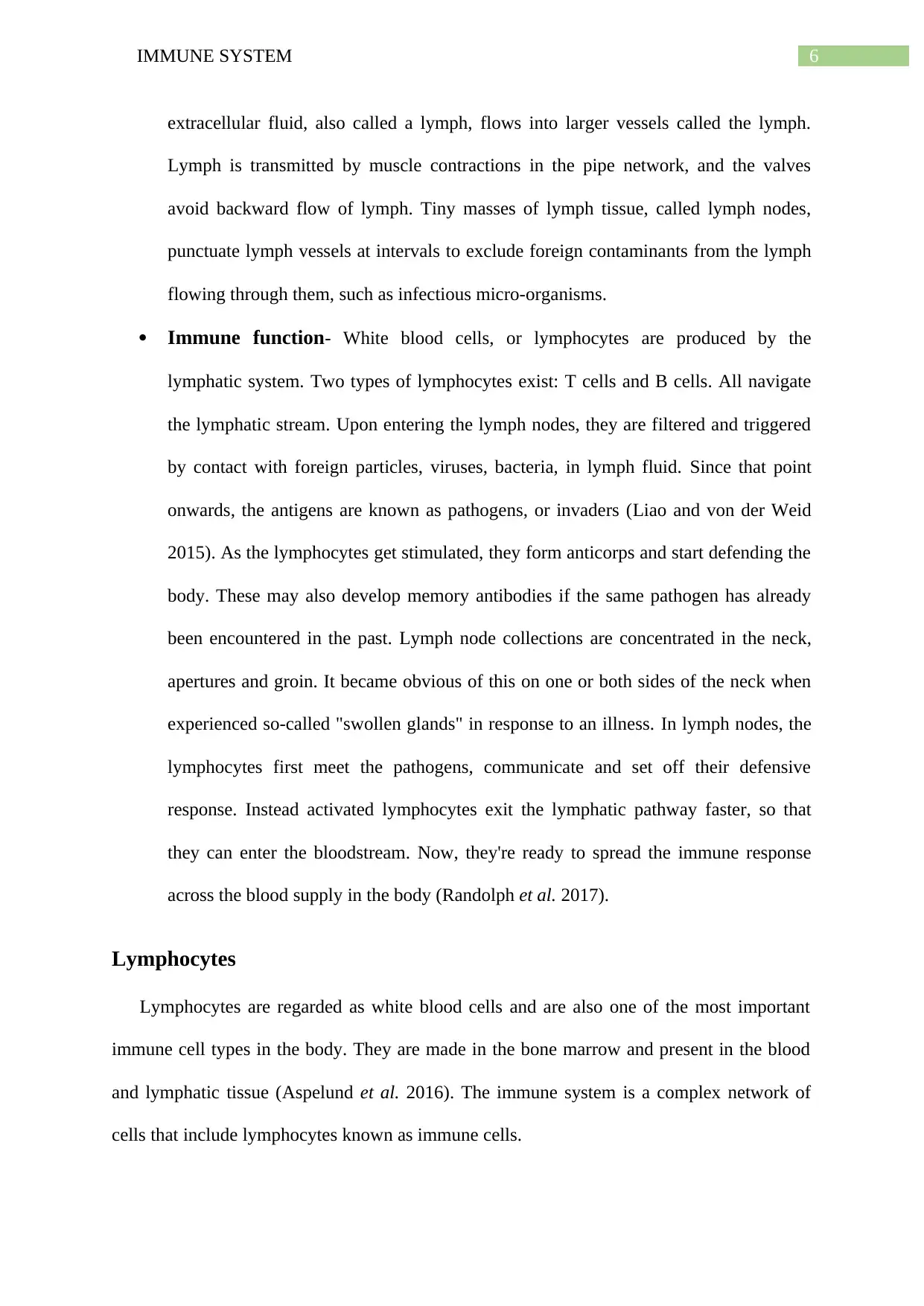
6IMMUNE SYSTEM
extracellular fluid, also called a lymph, flows into larger vessels called the lymph.
Lymph is transmitted by muscle contractions in the pipe network, and the valves
avoid backward flow of lymph. Tiny masses of lymph tissue, called lymph nodes,
punctuate lymph vessels at intervals to exclude foreign contaminants from the lymph
flowing through them, such as infectious micro-organisms.
Immune function- White blood cells, or lymphocytes are produced by the
lymphatic system. Two types of lymphocytes exist: T cells and B cells. All navigate
the lymphatic stream. Upon entering the lymph nodes, they are filtered and triggered
by contact with foreign particles, viruses, bacteria, in lymph fluid. Since that point
onwards, the antigens are known as pathogens, or invaders (Liao and von der Weid
2015). As the lymphocytes get stimulated, they form anticorps and start defending the
body. These may also develop memory antibodies if the same pathogen has already
been encountered in the past. Lymph node collections are concentrated in the neck,
apertures and groin. It became obvious of this on one or both sides of the neck when
experienced so-called "swollen glands" in response to an illness. In lymph nodes, the
lymphocytes first meet the pathogens, communicate and set off their defensive
response. Instead activated lymphocytes exit the lymphatic pathway faster, so that
they can enter the bloodstream. Now, they're ready to spread the immune response
across the blood supply in the body (Randolph et al. 2017).
Lymphocytes
Lymphocytes are regarded as white blood cells and are also one of the most important
immune cell types in the body. They are made in the bone marrow and present in the blood
and lymphatic tissue (Aspelund et al. 2016). The immune system is a complex network of
cells that include lymphocytes known as immune cells.
extracellular fluid, also called a lymph, flows into larger vessels called the lymph.
Lymph is transmitted by muscle contractions in the pipe network, and the valves
avoid backward flow of lymph. Tiny masses of lymph tissue, called lymph nodes,
punctuate lymph vessels at intervals to exclude foreign contaminants from the lymph
flowing through them, such as infectious micro-organisms.
Immune function- White blood cells, or lymphocytes are produced by the
lymphatic system. Two types of lymphocytes exist: T cells and B cells. All navigate
the lymphatic stream. Upon entering the lymph nodes, they are filtered and triggered
by contact with foreign particles, viruses, bacteria, in lymph fluid. Since that point
onwards, the antigens are known as pathogens, or invaders (Liao and von der Weid
2015). As the lymphocytes get stimulated, they form anticorps and start defending the
body. These may also develop memory antibodies if the same pathogen has already
been encountered in the past. Lymph node collections are concentrated in the neck,
apertures and groin. It became obvious of this on one or both sides of the neck when
experienced so-called "swollen glands" in response to an illness. In lymph nodes, the
lymphocytes first meet the pathogens, communicate and set off their defensive
response. Instead activated lymphocytes exit the lymphatic pathway faster, so that
they can enter the bloodstream. Now, they're ready to spread the immune response
across the blood supply in the body (Randolph et al. 2017).
Lymphocytes
Lymphocytes are regarded as white blood cells and are also one of the most important
immune cell types in the body. They are made in the bone marrow and present in the blood
and lymphatic tissue (Aspelund et al. 2016). The immune system is a complex network of
cells that include lymphocytes known as immune cells.
Paraphrase This Document
Need a fresh take? Get an instant paraphrase of this document with our AI Paraphraser
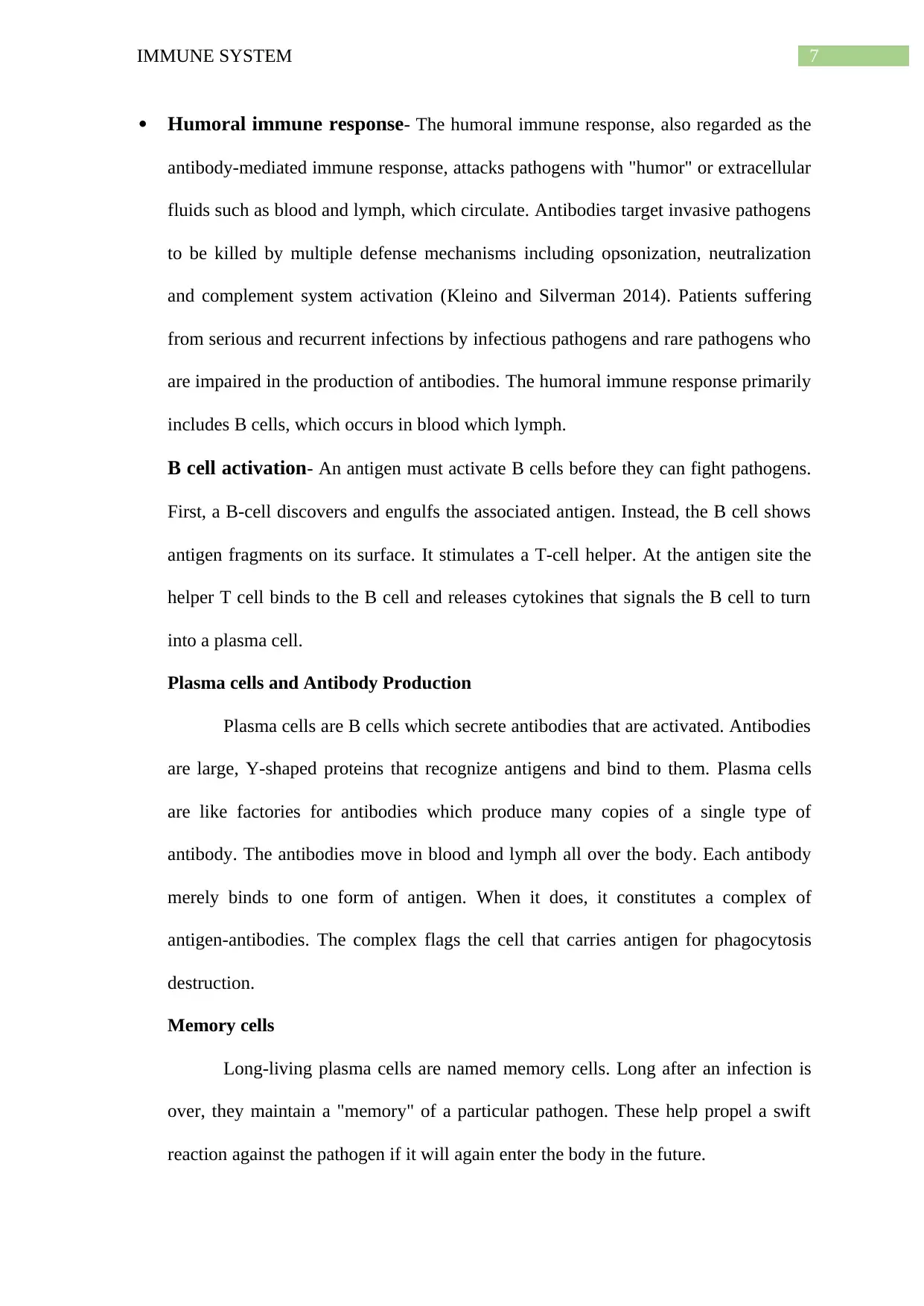
7IMMUNE SYSTEM
Humoral immune response- The humoral immune response, also regarded as the
antibody-mediated immune response, attacks pathogens with "humor" or extracellular
fluids such as blood and lymph, which circulate. Antibodies target invasive pathogens
to be killed by multiple defense mechanisms including opsonization, neutralization
and complement system activation (Kleino and Silverman 2014). Patients suffering
from serious and recurrent infections by infectious pathogens and rare pathogens who
are impaired in the production of antibodies. The humoral immune response primarily
includes B cells, which occurs in blood which lymph.
B cell activation- An antigen must activate B cells before they can fight pathogens.
First, a B-cell discovers and engulfs the associated antigen. Instead, the B cell shows
antigen fragments on its surface. It stimulates a T-cell helper. At the antigen site the
helper T cell binds to the B cell and releases cytokines that signals the B cell to turn
into a plasma cell.
Plasma cells and Antibody Production
Plasma cells are B cells which secrete antibodies that are activated. Antibodies
are large, Y-shaped proteins that recognize antigens and bind to them. Plasma cells
are like factories for antibodies which produce many copies of a single type of
antibody. The antibodies move in blood and lymph all over the body. Each antibody
merely binds to one form of antigen. When it does, it constitutes a complex of
antigen-antibodies. The complex flags the cell that carries antigen for phagocytosis
destruction.
Memory cells
Long-living plasma cells are named memory cells. Long after an infection is
over, they maintain a "memory" of a particular pathogen. These help propel a swift
reaction against the pathogen if it will again enter the body in the future.
Humoral immune response- The humoral immune response, also regarded as the
antibody-mediated immune response, attacks pathogens with "humor" or extracellular
fluids such as blood and lymph, which circulate. Antibodies target invasive pathogens
to be killed by multiple defense mechanisms including opsonization, neutralization
and complement system activation (Kleino and Silverman 2014). Patients suffering
from serious and recurrent infections by infectious pathogens and rare pathogens who
are impaired in the production of antibodies. The humoral immune response primarily
includes B cells, which occurs in blood which lymph.
B cell activation- An antigen must activate B cells before they can fight pathogens.
First, a B-cell discovers and engulfs the associated antigen. Instead, the B cell shows
antigen fragments on its surface. It stimulates a T-cell helper. At the antigen site the
helper T cell binds to the B cell and releases cytokines that signals the B cell to turn
into a plasma cell.
Plasma cells and Antibody Production
Plasma cells are B cells which secrete antibodies that are activated. Antibodies
are large, Y-shaped proteins that recognize antigens and bind to them. Plasma cells
are like factories for antibodies which produce many copies of a single type of
antibody. The antibodies move in blood and lymph all over the body. Each antibody
merely binds to one form of antigen. When it does, it constitutes a complex of
antigen-antibodies. The complex flags the cell that carries antigen for phagocytosis
destruction.
Memory cells
Long-living plasma cells are named memory cells. Long after an infection is
over, they maintain a "memory" of a particular pathogen. These help propel a swift
reaction against the pathogen if it will again enter the body in the future.
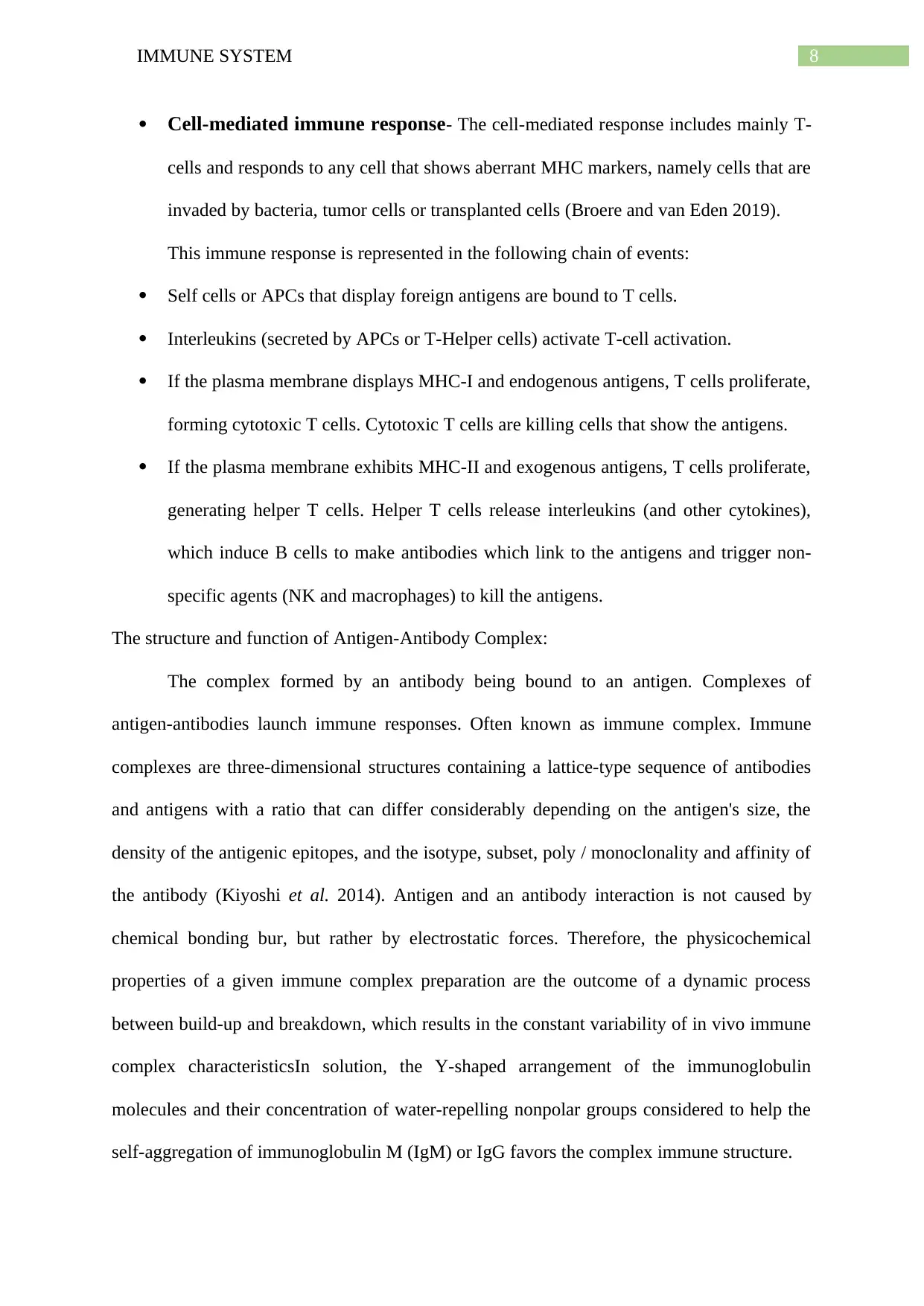
8IMMUNE SYSTEM
Cell-mediated immune response- The cell-mediated response includes mainly T-
cells and responds to any cell that shows aberrant MHC markers, namely cells that are
invaded by bacteria, tumor cells or transplanted cells (Broere and van Eden 2019).
This immune response is represented in the following chain of events:
Self cells or APCs that display foreign antigens are bound to T cells.
Interleukins (secreted by APCs or T-Helper cells) activate T-cell activation.
If the plasma membrane displays MHC‐I and endogenous antigens, T cells proliferate,
forming cytotoxic T cells. Cytotoxic T cells are killing cells that show the antigens.
If the plasma membrane exhibits MHC‐II and exogenous antigens, T cells proliferate,
generating helper T cells. Helper T cells release interleukins (and other cytokines),
which induce B cells to make antibodies which link to the antigens and trigger non-
specific agents (NK and macrophages) to kill the antigens.
The structure and function of Antigen-Antibody Complex:
The complex formed by an antibody being bound to an antigen. Complexes of
antigen-antibodies launch immune responses. Often known as immune complex. Immune
complexes are three-dimensional structures containing a lattice-type sequence of antibodies
and antigens with a ratio that can differ considerably depending on the antigen's size, the
density of the antigenic epitopes, and the isotype, subset, poly / monoclonality and affinity of
the antibody (Kiyoshi et al. 2014). Antigen and an antibody interaction is not caused by
chemical bonding bur, but rather by electrostatic forces. Therefore, the physicochemical
properties of a given immune complex preparation are the outcome of a dynamic process
between build-up and breakdown, which results in the constant variability of in vivo immune
complex characteristicsIn solution, the Y-shaped arrangement of the immunoglobulin
molecules and their concentration of water-repelling nonpolar groups considered to help the
self-aggregation of immunoglobulin M (IgM) or IgG favors the complex immune structure.
Cell-mediated immune response- The cell-mediated response includes mainly T-
cells and responds to any cell that shows aberrant MHC markers, namely cells that are
invaded by bacteria, tumor cells or transplanted cells (Broere and van Eden 2019).
This immune response is represented in the following chain of events:
Self cells or APCs that display foreign antigens are bound to T cells.
Interleukins (secreted by APCs or T-Helper cells) activate T-cell activation.
If the plasma membrane displays MHC‐I and endogenous antigens, T cells proliferate,
forming cytotoxic T cells. Cytotoxic T cells are killing cells that show the antigens.
If the plasma membrane exhibits MHC‐II and exogenous antigens, T cells proliferate,
generating helper T cells. Helper T cells release interleukins (and other cytokines),
which induce B cells to make antibodies which link to the antigens and trigger non-
specific agents (NK and macrophages) to kill the antigens.
The structure and function of Antigen-Antibody Complex:
The complex formed by an antibody being bound to an antigen. Complexes of
antigen-antibodies launch immune responses. Often known as immune complex. Immune
complexes are three-dimensional structures containing a lattice-type sequence of antibodies
and antigens with a ratio that can differ considerably depending on the antigen's size, the
density of the antigenic epitopes, and the isotype, subset, poly / monoclonality and affinity of
the antibody (Kiyoshi et al. 2014). Antigen and an antibody interaction is not caused by
chemical bonding bur, but rather by electrostatic forces. Therefore, the physicochemical
properties of a given immune complex preparation are the outcome of a dynamic process
between build-up and breakdown, which results in the constant variability of in vivo immune
complex characteristicsIn solution, the Y-shaped arrangement of the immunoglobulin
molecules and their concentration of water-repelling nonpolar groups considered to help the
self-aggregation of immunoglobulin M (IgM) or IgG favors the complex immune structure.
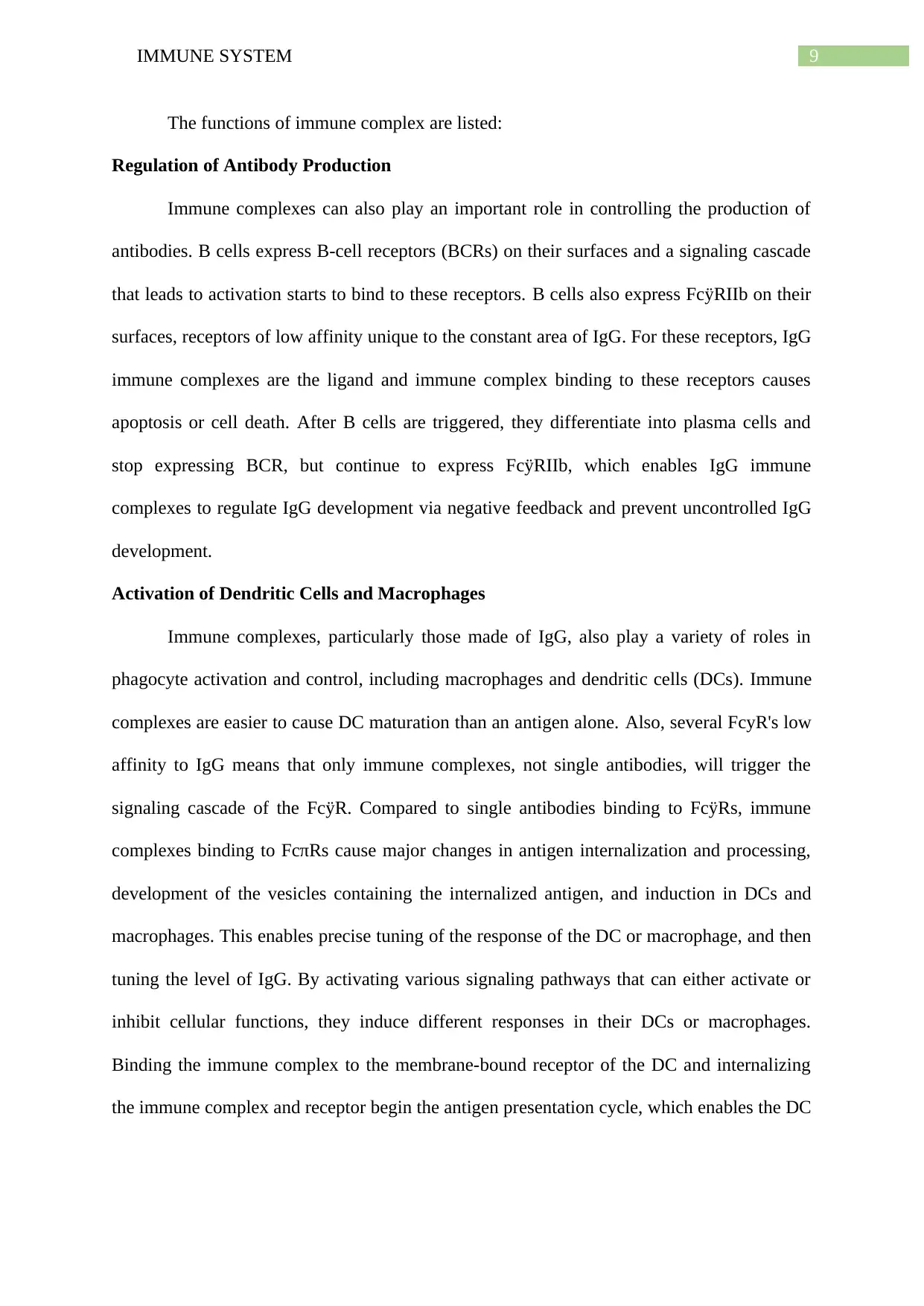
9IMMUNE SYSTEM
The functions of immune complex are listed:
Regulation of Antibody Production
Immune complexes can also play an important role in controlling the production of
antibodies. B cells express B-cell receptors (BCRs) on their surfaces and a signaling cascade
that leads to activation starts to bind to these receptors. B cells also express FcÿRIIb on their
surfaces, receptors of low affinity unique to the constant area of IgG. For these receptors, IgG
immune complexes are the ligand and immune complex binding to these receptors causes
apoptosis or cell death. After B cells are triggered, they differentiate into plasma cells and
stop expressing BCR, but continue to express FcÿRIIb, which enables IgG immune
complexes to regulate IgG development via negative feedback and prevent uncontrolled IgG
development.
Activation of Dendritic Cells and Macrophages
Immune complexes, particularly those made of IgG, also play a variety of roles in
phagocyte activation and control, including macrophages and dendritic cells (DCs). Immune
complexes are easier to cause DC maturation than an antigen alone. Also, several FcyR's low
affinity to IgG means that only immune complexes, not single antibodies, will trigger the
signaling cascade of the FcÿR. Compared to single antibodies binding to FcÿRs, immune
complexes binding to FcπRs cause major changes in antigen internalization and processing,
development of the vesicles containing the internalized antigen, and induction in DCs and
macrophages. This enables precise tuning of the response of the DC or macrophage, and then
tuning the level of IgG. By activating various signaling pathways that can either activate or
inhibit cellular functions, they induce different responses in their DCs or macrophages.
Binding the immune complex to the membrane-bound receptor of the DC and internalizing
the immune complex and receptor begin the antigen presentation cycle, which enables the DC
The functions of immune complex are listed:
Regulation of Antibody Production
Immune complexes can also play an important role in controlling the production of
antibodies. B cells express B-cell receptors (BCRs) on their surfaces and a signaling cascade
that leads to activation starts to bind to these receptors. B cells also express FcÿRIIb on their
surfaces, receptors of low affinity unique to the constant area of IgG. For these receptors, IgG
immune complexes are the ligand and immune complex binding to these receptors causes
apoptosis or cell death. After B cells are triggered, they differentiate into plasma cells and
stop expressing BCR, but continue to express FcÿRIIb, which enables IgG immune
complexes to regulate IgG development via negative feedback and prevent uncontrolled IgG
development.
Activation of Dendritic Cells and Macrophages
Immune complexes, particularly those made of IgG, also play a variety of roles in
phagocyte activation and control, including macrophages and dendritic cells (DCs). Immune
complexes are easier to cause DC maturation than an antigen alone. Also, several FcyR's low
affinity to IgG means that only immune complexes, not single antibodies, will trigger the
signaling cascade of the FcÿR. Compared to single antibodies binding to FcÿRs, immune
complexes binding to FcπRs cause major changes in antigen internalization and processing,
development of the vesicles containing the internalized antigen, and induction in DCs and
macrophages. This enables precise tuning of the response of the DC or macrophage, and then
tuning the level of IgG. By activating various signaling pathways that can either activate or
inhibit cellular functions, they induce different responses in their DCs or macrophages.
Binding the immune complex to the membrane-bound receptor of the DC and internalizing
the immune complex and receptor begin the antigen presentation cycle, which enables the DC
Secure Best Marks with AI Grader
Need help grading? Try our AI Grader for instant feedback on your assignments.
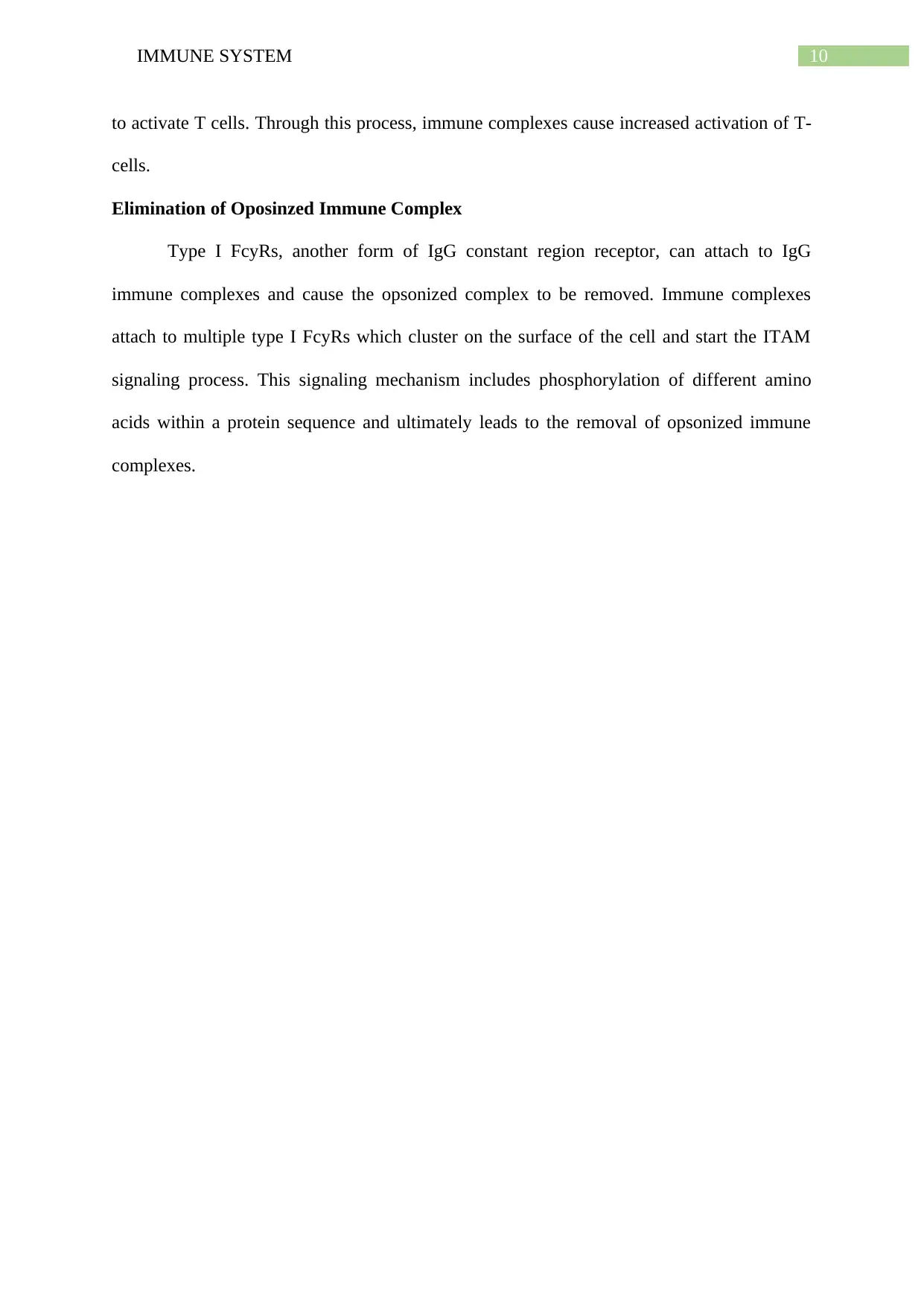
10IMMUNE SYSTEM
to activate T cells. Through this process, immune complexes cause increased activation of T-
cells.
Elimination of Oposinzed Immune Complex
Type I FcyRs, another form of IgG constant region receptor, can attach to IgG
immune complexes and cause the opsonized complex to be removed. Immune complexes
attach to multiple type I FcyRs which cluster on the surface of the cell and start the ITAM
signaling process. This signaling mechanism includes phosphorylation of different amino
acids within a protein sequence and ultimately leads to the removal of opsonized immune
complexes.
to activate T cells. Through this process, immune complexes cause increased activation of T-
cells.
Elimination of Oposinzed Immune Complex
Type I FcyRs, another form of IgG constant region receptor, can attach to IgG
immune complexes and cause the opsonized complex to be removed. Immune complexes
attach to multiple type I FcyRs which cluster on the surface of the cell and start the ITAM
signaling process. This signaling mechanism includes phosphorylation of different amino
acids within a protein sequence and ultimately leads to the removal of opsonized immune
complexes.
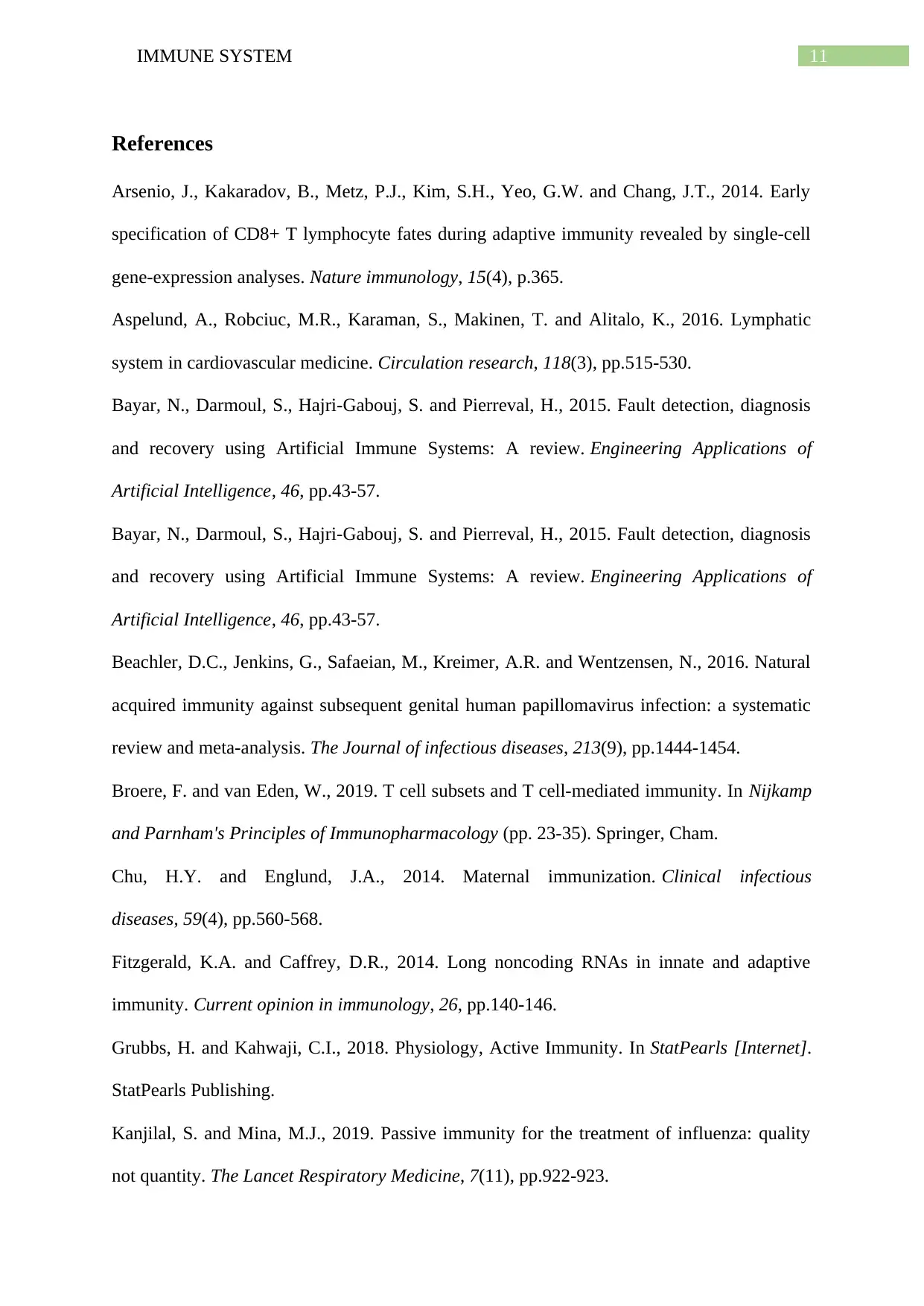
11IMMUNE SYSTEM
References
Arsenio, J., Kakaradov, B., Metz, P.J., Kim, S.H., Yeo, G.W. and Chang, J.T., 2014. Early
specification of CD8+ T lymphocyte fates during adaptive immunity revealed by single-cell
gene-expression analyses. Nature immunology, 15(4), p.365.
Aspelund, A., Robciuc, M.R., Karaman, S., Makinen, T. and Alitalo, K., 2016. Lymphatic
system in cardiovascular medicine. Circulation research, 118(3), pp.515-530.
Bayar, N., Darmoul, S., Hajri-Gabouj, S. and Pierreval, H., 2015. Fault detection, diagnosis
and recovery using Artificial Immune Systems: A review. Engineering Applications of
Artificial Intelligence, 46, pp.43-57.
Bayar, N., Darmoul, S., Hajri-Gabouj, S. and Pierreval, H., 2015. Fault detection, diagnosis
and recovery using Artificial Immune Systems: A review. Engineering Applications of
Artificial Intelligence, 46, pp.43-57.
Beachler, D.C., Jenkins, G., Safaeian, M., Kreimer, A.R. and Wentzensen, N., 2016. Natural
acquired immunity against subsequent genital human papillomavirus infection: a systematic
review and meta-analysis. The Journal of infectious diseases, 213(9), pp.1444-1454.
Broere, F. and van Eden, W., 2019. T cell subsets and T cell-mediated immunity. In Nijkamp
and Parnham's Principles of Immunopharmacology (pp. 23-35). Springer, Cham.
Chu, H.Y. and Englund, J.A., 2014. Maternal immunization. Clinical infectious
diseases, 59(4), pp.560-568.
Fitzgerald, K.A. and Caffrey, D.R., 2014. Long noncoding RNAs in innate and adaptive
immunity. Current opinion in immunology, 26, pp.140-146.
Grubbs, H. and Kahwaji, C.I., 2018. Physiology, Active Immunity. In StatPearls [Internet].
StatPearls Publishing.
Kanjilal, S. and Mina, M.J., 2019. Passive immunity for the treatment of influenza: quality
not quantity. The Lancet Respiratory Medicine, 7(11), pp.922-923.
References
Arsenio, J., Kakaradov, B., Metz, P.J., Kim, S.H., Yeo, G.W. and Chang, J.T., 2014. Early
specification of CD8+ T lymphocyte fates during adaptive immunity revealed by single-cell
gene-expression analyses. Nature immunology, 15(4), p.365.
Aspelund, A., Robciuc, M.R., Karaman, S., Makinen, T. and Alitalo, K., 2016. Lymphatic
system in cardiovascular medicine. Circulation research, 118(3), pp.515-530.
Bayar, N., Darmoul, S., Hajri-Gabouj, S. and Pierreval, H., 2015. Fault detection, diagnosis
and recovery using Artificial Immune Systems: A review. Engineering Applications of
Artificial Intelligence, 46, pp.43-57.
Bayar, N., Darmoul, S., Hajri-Gabouj, S. and Pierreval, H., 2015. Fault detection, diagnosis
and recovery using Artificial Immune Systems: A review. Engineering Applications of
Artificial Intelligence, 46, pp.43-57.
Beachler, D.C., Jenkins, G., Safaeian, M., Kreimer, A.R. and Wentzensen, N., 2016. Natural
acquired immunity against subsequent genital human papillomavirus infection: a systematic
review and meta-analysis. The Journal of infectious diseases, 213(9), pp.1444-1454.
Broere, F. and van Eden, W., 2019. T cell subsets and T cell-mediated immunity. In Nijkamp
and Parnham's Principles of Immunopharmacology (pp. 23-35). Springer, Cham.
Chu, H.Y. and Englund, J.A., 2014. Maternal immunization. Clinical infectious
diseases, 59(4), pp.560-568.
Fitzgerald, K.A. and Caffrey, D.R., 2014. Long noncoding RNAs in innate and adaptive
immunity. Current opinion in immunology, 26, pp.140-146.
Grubbs, H. and Kahwaji, C.I., 2018. Physiology, Active Immunity. In StatPearls [Internet].
StatPearls Publishing.
Kanjilal, S. and Mina, M.J., 2019. Passive immunity for the treatment of influenza: quality
not quantity. The Lancet Respiratory Medicine, 7(11), pp.922-923.
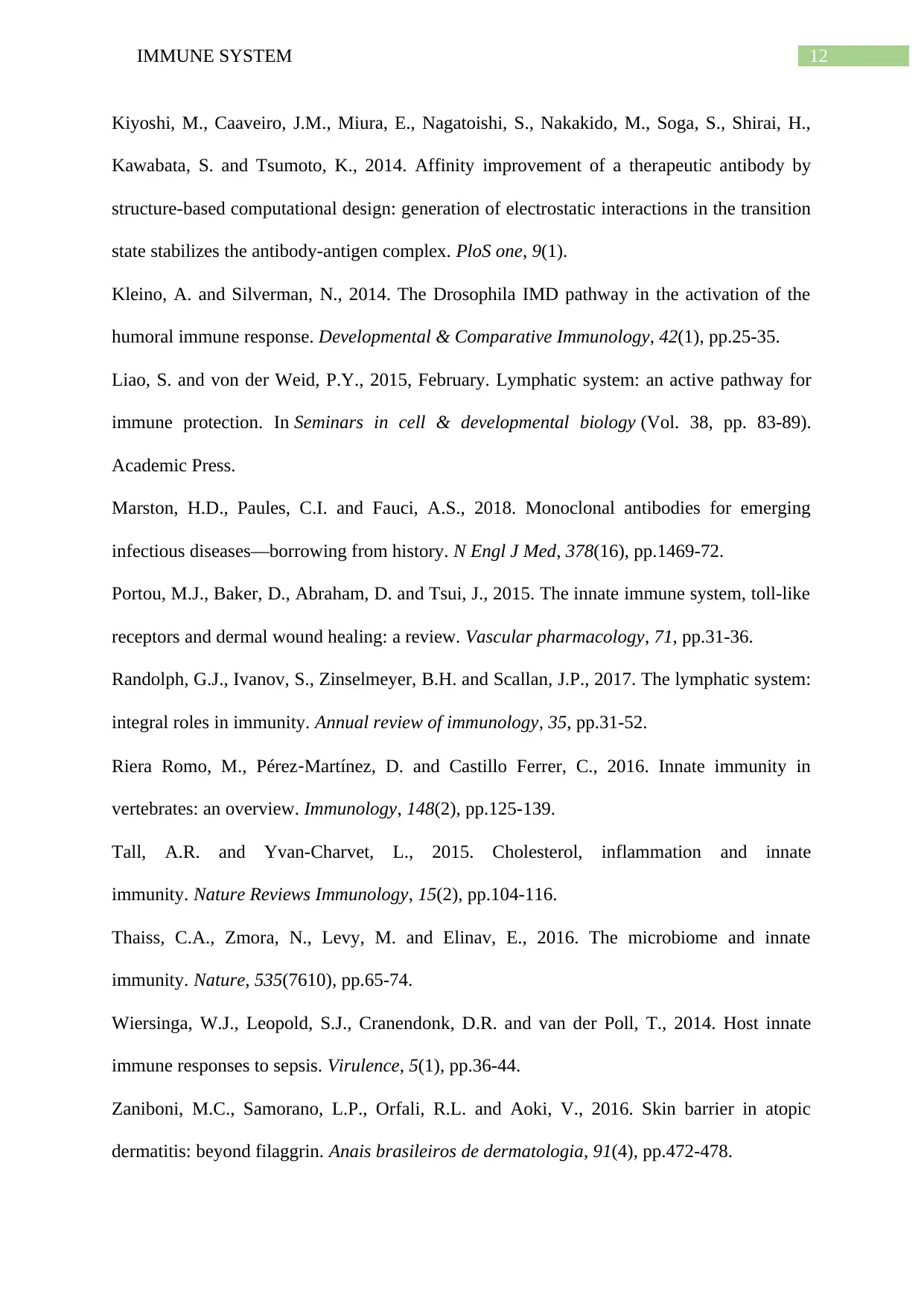
12IMMUNE SYSTEM
Kiyoshi, M., Caaveiro, J.M., Miura, E., Nagatoishi, S., Nakakido, M., Soga, S., Shirai, H.,
Kawabata, S. and Tsumoto, K., 2014. Affinity improvement of a therapeutic antibody by
structure-based computational design: generation of electrostatic interactions in the transition
state stabilizes the antibody-antigen complex. PloS one, 9(1).
Kleino, A. and Silverman, N., 2014. The Drosophila IMD pathway in the activation of the
humoral immune response. Developmental & Comparative Immunology, 42(1), pp.25-35.
Liao, S. and von der Weid, P.Y., 2015, February. Lymphatic system: an active pathway for
immune protection. In Seminars in cell & developmental biology (Vol. 38, pp. 83-89).
Academic Press.
Marston, H.D., Paules, C.I. and Fauci, A.S., 2018. Monoclonal antibodies for emerging
infectious diseases—borrowing from history. N Engl J Med, 378(16), pp.1469-72.
Portou, M.J., Baker, D., Abraham, D. and Tsui, J., 2015. The innate immune system, toll-like
receptors and dermal wound healing: a review. Vascular pharmacology, 71, pp.31-36.
Randolph, G.J., Ivanov, S., Zinselmeyer, B.H. and Scallan, J.P., 2017. The lymphatic system:
integral roles in immunity. Annual review of immunology, 35, pp.31-52.
Riera Romo, M., Pérez‐Martínez, D. and Castillo Ferrer, C., 2016. Innate immunity in
vertebrates: an overview. Immunology, 148(2), pp.125-139.
Tall, A.R. and Yvan-Charvet, L., 2015. Cholesterol, inflammation and innate
immunity. Nature Reviews Immunology, 15(2), pp.104-116.
Thaiss, C.A., Zmora, N., Levy, M. and Elinav, E., 2016. The microbiome and innate
immunity. Nature, 535(7610), pp.65-74.
Wiersinga, W.J., Leopold, S.J., Cranendonk, D.R. and van der Poll, T., 2014. Host innate
immune responses to sepsis. Virulence, 5(1), pp.36-44.
Zaniboni, M.C., Samorano, L.P., Orfali, R.L. and Aoki, V., 2016. Skin barrier in atopic
dermatitis: beyond filaggrin. Anais brasileiros de dermatologia, 91(4), pp.472-478.
Kiyoshi, M., Caaveiro, J.M., Miura, E., Nagatoishi, S., Nakakido, M., Soga, S., Shirai, H.,
Kawabata, S. and Tsumoto, K., 2014. Affinity improvement of a therapeutic antibody by
structure-based computational design: generation of electrostatic interactions in the transition
state stabilizes the antibody-antigen complex. PloS one, 9(1).
Kleino, A. and Silverman, N., 2014. The Drosophila IMD pathway in the activation of the
humoral immune response. Developmental & Comparative Immunology, 42(1), pp.25-35.
Liao, S. and von der Weid, P.Y., 2015, February. Lymphatic system: an active pathway for
immune protection. In Seminars in cell & developmental biology (Vol. 38, pp. 83-89).
Academic Press.
Marston, H.D., Paules, C.I. and Fauci, A.S., 2018. Monoclonal antibodies for emerging
infectious diseases—borrowing from history. N Engl J Med, 378(16), pp.1469-72.
Portou, M.J., Baker, D., Abraham, D. and Tsui, J., 2015. The innate immune system, toll-like
receptors and dermal wound healing: a review. Vascular pharmacology, 71, pp.31-36.
Randolph, G.J., Ivanov, S., Zinselmeyer, B.H. and Scallan, J.P., 2017. The lymphatic system:
integral roles in immunity. Annual review of immunology, 35, pp.31-52.
Riera Romo, M., Pérez‐Martínez, D. and Castillo Ferrer, C., 2016. Innate immunity in
vertebrates: an overview. Immunology, 148(2), pp.125-139.
Tall, A.R. and Yvan-Charvet, L., 2015. Cholesterol, inflammation and innate
immunity. Nature Reviews Immunology, 15(2), pp.104-116.
Thaiss, C.A., Zmora, N., Levy, M. and Elinav, E., 2016. The microbiome and innate
immunity. Nature, 535(7610), pp.65-74.
Wiersinga, W.J., Leopold, S.J., Cranendonk, D.R. and van der Poll, T., 2014. Host innate
immune responses to sepsis. Virulence, 5(1), pp.36-44.
Zaniboni, M.C., Samorano, L.P., Orfali, R.L. and Aoki, V., 2016. Skin barrier in atopic
dermatitis: beyond filaggrin. Anais brasileiros de dermatologia, 91(4), pp.472-478.
Paraphrase This Document
Need a fresh take? Get an instant paraphrase of this document with our AI Paraphraser

13IMMUNE SYSTEM
1 out of 14
Related Documents
Your All-in-One AI-Powered Toolkit for Academic Success.
+13062052269
info@desklib.com
Available 24*7 on WhatsApp / Email
![[object Object]](/_next/static/media/star-bottom.7253800d.svg)
Unlock your academic potential
© 2024 | Zucol Services PVT LTD | All rights reserved.





